Abstract
Wood is a natural raw material that is an integral part of many production processes. By changing the input characteristics of native wood, the qualitative characteristics of the final product can be affected extensively. This article is concerned with examining several factors’ effects (thickness of the material; number of loading cycles) on the bending strength of beech wood during bending in the radial direction. A three-point bending test was used on the sample. The examined properties were investigated on samples of varying thicknesses that were not cyclically loaded, and the results were compared to those acquired from samples that were cyclically loaded. Thirty percent densification of the samples was achieved by rolling. Material fatigue was not achieved as an effect of examined number of cycles, nor did the examined characteristics change as an effect of cyclic loading. Densification of the wood by rolling had no effect on the changes in the examined mechanical properties at the determined level of densification. With an increase in the material’s thickness, the values of the examined characteristics decreased, which was caused by the fact that the increase in the cross-sectional modulus of the material was greater than the increase of the affecting force.
Download PDF
Full Article
Effects of Selected Factors on Bending Characteristics of Beech Wood
Elena Miftieva, Milan Gaff,* Tomáš Svoboda, Marián Babiak, Miroslav Gašparík, Daniel Ruman, and Miroslav Suchopár
Wood is a natural raw material that is an integral part of many production processes. By changing the input characteristics of native wood, the qualitative characteristics of the final product can be affected extensively. This article is concerned with examining several factors’ effects (thickness of the material; number of loading cycles) on the bending strength of beech wood during bending in the radial direction. A three-point bending test was used on the sample. The examined properties were investigated on samples of varying thicknesses that were not cyclically loaded, and the results were compared to those acquired from samples that were cyclically loaded. Thirty percent densification of the samples was achieved by rolling. Material fatigue was not achieved as an effect of examined number of cycles, nor did the examined characteristics change as an effect of cyclic loading. Densification of the wood by rolling had no effect on the changes in the examined mechanical properties at the determined level of densification. With an increase in the material’s thickness, the values of the examined characteristics decreased, which was caused by the fact that the increase in the cross-sectional modulus of the material was greater than the increase of the affecting force.
Keywords: Cyclic loading; Wood densification; Bending strength; Modulus of elasticity; Beech wood
Contact information: Department of Wood Processing, Czech University of Life Sciences in Prague, Kamýcká 1176, Praha 6 – Suchdol, 16521 Czech Republic; *Corresponding author: gaffmilan@gmail.com
INTRODUCTION
Wood is a natural, renewable material of versatile utilization, characterized by both positive and negative natural properties. However, most of its physical-mechanical properties can be altered by intentional changes. In the wood processing industry, new technologies for diminishing undesirable wood properties and broadening possible applications of wood in unconventional ways are continually being researched (Kurjatko et al. 2010).
One of the general functions of a manufacturing system is transforming the materials and semi-products into a product that fulfills the desired function parameters. In a production sector, the system runs on precisely determined transformation of input material elements to the material elements of the output (Gaff 2014).<0}
The input material is a crucial variable affecting the manufacture process, because the material alters the quantitative and qualitative properties of the final product. Wood that is
either a native or modified raw material can be input in the manufacturing process, and in some cases the modification takes place directly during the production process (Kurjatko et al. 2010).
By intentional modification of the material it is possible, to a certain extent, to influence undesirable properties of wood and therefore increase the number of options for its application. By modification of the wood properties by mechanical, thermal, or chemical treatments, or some combination of the three, materials with specific properties can be obtained for technological and industrial utilization (Kurjatko et al. 2010; Gaff et al. 2010; Gaff and Gáborík 2014).
Wood densification is a mechanical method of modifying basic wood properties. It is a modification technology in which the wood is pressed, e.g., by rolling, in order to reduce its volume and simultaneously increase its density (Kamke 2006). This technology is used primarily in the furniture industry, but also in the construction industry (Blomberg and Persson 2007; Kurjatko et al. 2010; Laine et al. 2013; Gaff and Gašparík 2015). Using wood densification, a qualitative change in the wood’s properties can be achieved, and therefore a material of enhanced properties can be obtained (Blomberg et al. 2005). The final product is characterized by enhanced physical-mechanical properties compared to the corresponding non-densified timber, which increases its potential utilization (Kurjatko et al. 2010; Zemiar et al. 2011; Fang et al. 2012). This shows that it is possible to determine and influence the properties of the final product using knowledge of the properties of wood as a raw input material (Kurjatko et al. 2010). Modulus of elasticity at bending and bending strength are the most frequently researched characteristics. This is justified by the fact that these properties have a significant impact on the usability of materials that are utilized in building materials (girders, squared logs) and in the furniture industry (lamella elements) (Gaff and Gáborík 2014).
Knowledge of the individual properties of construction materials and the evaluation of the interaction between factors that affect these properties is the foundation for correct application of these materials. This research is focused on examining the strength characteristics of beech wood during static bending perpendicular to the fibers in the radial direction.
The main goal is to determine the effect of densification, cyclic loading, and thickness of the examined samples on the bending strength and modulus of elasticity of solid beech wood. The purpose of this work is to study the cyclic loading effect on the bending strength and elasticity features for beech solid wood. The lifetime of these products varies considerably due to the material properties. In addition, this work will extend the knowledge of the fabrication of these products, which should, to a significant degree, define the impact of the modulus of elasticity on the given mechanical feature to assist in the creation of high-quality furniture products. It is understood that the overall lifetime of the furniture products is affected by the lifetime of the individual elements.
EXPERIMENTAL
Materials
Samples of beech wood (Fagus sylvatica L.) were used for the experiments.
The purpose of the research was the experimental assessment of the effects of cyclic loading, densification (native wood densified by 30%), and the samples’ thickness on the bending strength (σp) and the modulus of elasticity (Em) during bending perpendicular to the fibers in the radial direction.For the purpose of performing the tests to assess the selected characteristics, the samples were divided into two sets.One set was modified by densification, whereas the second set was made up of non-densified samples.
Assessment of the observed characteristics took place before and after cyclic loading of the samples. Individual sets of samples were cyclically loaded for 0, 1,000, 3,000, and 7,000 cycles. To determine the effect of the thickness of the material, tests were carried out on samples of 4, 6, 10, and 18 mm thick. The samples of densified wood were 2.8 mm, 4.2 mm, 7 mm, and 12.6 mm thick (before densification by 30%, the samples were of the same thicknesses as the non-densified wood samples). Subsequently, the samples were conditioned (ϕ = (42 ± 3) % and t = (20 ± 2) °C) to achieve a final moisture content of 8%. We compared 32 files test specimens. One set of test specimens was composed of 7 pieces. Categorization of sample set is shown at Fig. 1.

Fig. 1. Categorization of the sets of samples
Methods
Densification of the samples
One set of samples was modified by densification perpendicular to the fibers in the radial direction at a pressing level of 30%. The rolling was applied many times until 30% level was obtained. The degree of pressing was evaluated in relation to the original dimensions of the sample.
The method of rolling with continual load throughout the cross section was selected for the densification process. The rolling instrument operated on the principle of the pressing roller not affecting all of the densified material at once, rather only in the location of the rollers. The samples were in no way plasticized during densification and the pressure during the rolling process was 30 MPa.<0}

Fig. 2. Principle of wood densification by rolling (hp) – material thickness before densification, (hs) – thickness of the pressed wood, (hk) – final thickness of the material after densification, (α0) – pressure angle)
Cyclic loading
Cyclic loading of the samples was carried out using a special cyclic machine designed by the authors (Fig. 3). This machine periodically bent the samples by uniaxial load. For this experiment, 0, 1,000, 3,000, and 7,000 cycles were selected. The loading during the cyclic loading of the samples was applied at 90% of limit of proportionality of static bending test results, which was determined by preliminary experimental measurement. The value of 90% of limit of proportionality was set so that the elastic range was not violated as an effect of material heterogeneity.
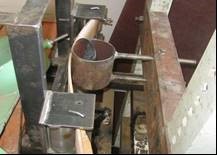
Fig. 3. Cyclic machine
The samples were loaded at a speed of 20 cycles per minute in the middle of their length. The bending strength tests perpendicular to the fibers in the radial direction were carried out before and after cyclic loading on the sets of samples treated this way.
BendingBBending strength and modulus of elasticity at bending
The assessment of the mechanical properties was carried out according to ISO 13061-3 (2014) and ISO 13061-4 (2014) on a universal testing machine FPZ 100/1 (HECKERT, Germany) so that the bend loading was applied in middle-length of the sample. These standards are concerned with determining the modulus of elasticity and bending strength. The samples of non-densified beech wood had dimensions of 4, 6, 10, 18 × 30 mm × 600 mm, while the densified samples had dimensions of 2.8, 4.2, 7, and 12. 6 × 30 mm × 600 mm. The basic scheme of the three-point bending is shown in Fig. 4.

Fig. 4. The method of arrangement of the samples during bending of sample, (F) – loading force, (h) – sample thickness, l1 – Center distance of supports, l2 The length of the test specimen.
The rate of loading was set in a manner in which the maximal loading force should be applied up to 90 s. Due to the rapid application of load, the values of force increased to an extreme degree, and the results would be distorted.
Evaluation and Calculation
The influence of factors on bending strength was statistically evaluated using ANOVA, mainly by Fisher’s F-test, in STATISTICA 12 software (Statsoft Inc., USA).
The bending strengths of the samples were calculated after cyclic loading. These calculations were carried out according to ISO 13061-3 (2014) and Eq. 1,
![]() (1)
(1)
where σb is the (ultimate) bending strength of wood (MPa), Fmax is the maximum loading (breaking) force (N), l1 is the distance between supports (mm), b is the width of the test sample (mm), and h is the thickness of the test sample (mm).
The bending strengths were recalculated for 12% moisture content according to ISO 13061-3 (2014) and Eq. 2,
![]() (2)
(2)
where σw is the bending strength of wood with the certain moisture content during testing (MPa), σ12 is the bending strength of wood at 12% moisture content (MPa), w is the moisture content of a sample during testing (%), and α is the correction coefficient of moisture content which is 0.04 for all of the wood species.
The modulus of elasticity at bending was calculated in accordance with ISO 13061-4 (2014) and Eq. 3,
![]() (3)
(3)
where Ew is the modulus of elasticity of wood (MPa), l1 is the distance between supports (mm), b is the width of the test sample (mm), h is the thickness of the test sample (mm), and F2 – F1 is the loading increase in the loading/deflection curve linear section (N). The value of F1 should be approximately 10% and F2 should be approximately 40% of the breaking load. The difference a2 – a1 is the deflection increase in midpoint of the sample length (corresponding to the loading increase F2 – F1).
The modulus of elasticity were recalculated for 12% moisture content according to Dubovský et al. (2001) and Eq. 4,
![]() (4)
(4)
where Ew12 is the modulus of elasticity at 12% moisture content of wood (MPa), EW is the modulus of elasticity at testing moisture content of wood (MPa), w is the moisture of the samples during the test (%), and α is the correction coefficient of moisture content for the modulus of elasticity which is 0.01 for all of the wood species.
The moisture content of samples was determined and verified before and after testing. These calculations were carried out according to ISO 13061-1 (2014) and by use of Eq. 5,
![]() (5)
(5)
where w is the moisture content of the samples (%); mw is the mass (weight) of the test sample at moisture content w (kg); and m0 is the mass (weight) of the oven-dry test sample (kg).
Drying to oven-dry state was also carried out according to ISO 13061-1 (2014).
RESULTS AND DISCUSSION
Bending Strength<0}
Table 1 contains the values of a three-factor analysis of variance, which reflects the statistical significance (P) of the effects of individual factors (number of loading cycles, densification, and material thickness) and their mutual interaction on the values of bending strength. Based on this data, it is possible to conclude that the material thickness can be considered as a statistically significant affecting factor. mThe number of cycles and densification had no statistical significance on the values of bending strength. The mutual interaction of all factors simultaneously had a statistically significant effect.
Table 1. Analysis of Variance Evaluating the Effects of Individual Factors and their Interaction on the Bending Strength
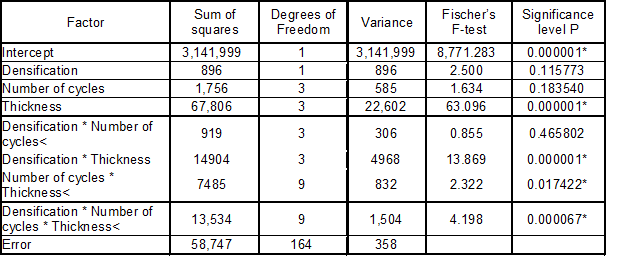
*Note: These are statistically significant parameters according to P<0.05, i.e., 95% confidence interval
As was apparent from the data (Table 1 and Fig. 5), wood densification had a statistically insignificant effect on the values of bending strength, because there was no marked difference when comparing non-densified wood with densified (modified) wood. Based on the values listed in the graph (Fig. 5), the slight decrease in bending strength for densified wood can be considered negligible.
However, densification had a statistically significant effect on the values of bending strength in the interaction with material thickness (Fig. 1). It is apparent from the graph (Fig. 6) that there is a statistically significant difference between sets of non-densified and densified wood. The densified wood in the range of 6 to 10 mm showed greater bending strength values than the non-densified wood. The increase in bending strength occurred because of the increase in the wood mass density. The effect of densification in combination with number of stress cycles did not prove statistically significant (Table 1 and Fig. 7).
In Fig. 7 it can be seen that in the range of 0 to 1000 cycles, densification had a negative effect on the bending strength, as opposed to the non-densified wood. However, in the range of 3,000 to 7,000 cycles, there were greater values of bending strength for densified wood compared to the non-densified wood. Nevertheless, these differences were not significant.
The effect of material thickness proved statistically significant for both densified and non-densified beech wood. As apparent from the graph (Fig. 6), the values of bending strength decreased significantly with an increase in material thickness. For the densified wood samples, the trend of decreasing bending strength values with increasing material thickness is clear. Statistically, the most significant difference was found at the material thicknesses of 6 mm, 10 mm, and 18 mm. The most significant difference for non-densified wood samples was evident in the thickness increase between 4 and 6 mm.
The decrease in bending strength with increasing material thickness is a consequence of the increase of the cross-section module being greater than the increase of the affecting force. Therefore, the increase in thickness results in an increase of the sample surface. The force consequently distributes over the increased area of the cross-section and a decrease in strength occurs.

It is possible to consider the effect of the observed number of stress cycles an insignificant factor on the bending strength values, concerning both the set of densified samples and the set of non-densified samples (Table 1 and Fig. 7). In the range of 3,000 to 7,000 cycles, a slight decrease in bending strength was apparent for both sets of samples. Nonetheless, this occurrence was not statistically significant.
According to the graphs of 95% confidence intervals illustrating the effects of material thickness, densification, and number of cycles on the bending strength of the densified beech wood (Table 1 and Fig. 8), it can be concluded that the interaction of the three observed factors had a statistically significant effect. It can also be observed that this effect was a consequence of the significant effect of material thickness.
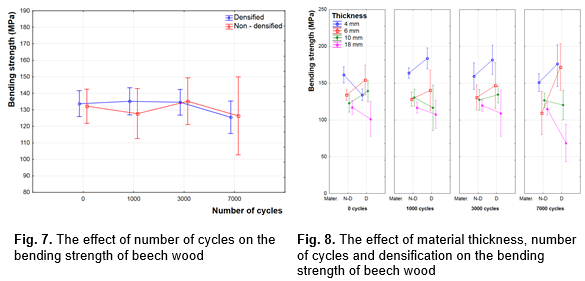
Modulus of Elasticity<0}
To evaluate the effects of the selected factors on the modulus of elasticity affecting bending, a three-factor analysis of variance was used in order to elucidate the effects of individual factors and their mutual interactions on the modulus of elasticity.
Based on the values of the significance level (P), which are listed in Table 2, it is apparent that the effects of all of the examined characteristics and their interactions were statistically significant. However, densification can be considered statistically insignificant.
Table 2. Analysis of Variance Evaluating the Effects of Individual Factors and its Interaction on the Modulus of Elasticity
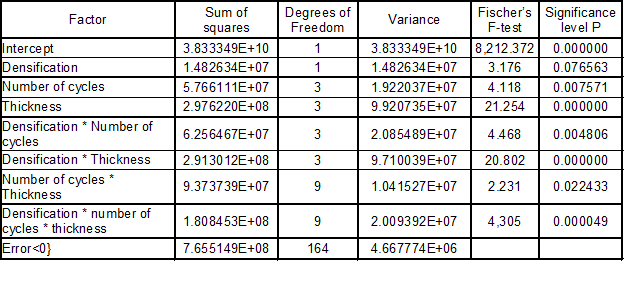
*Note: The numbers are statistically significant values according to P<0.05, i.e. 95% confidence interval
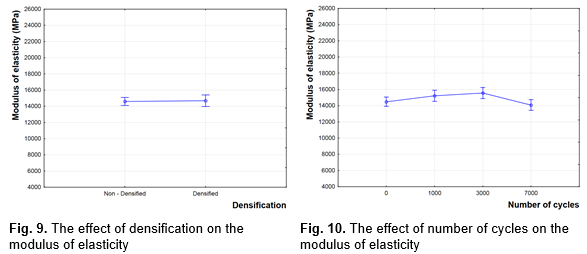
From Fig. 9, it is apparent that densification had a statistically insignificant effect on the values of the examined characteristic. An interesting statistically significant result was found when examining the number of cycles (Fig. 10). From the values listed in the graph, it is apparent that with an increase in the number of stress cycles in the range of 0 to 3,000, the values of modulus of elasticity also increased. At 7,000 cycles, it can be observed that a statistically significant decrease in values occurred. This decrease indicates that in the range of 3,000 to 7,000, there is a fatigue limit at which an observable decrease in the values of modulus of elasticity occurs.
With an increase in the material thickness (Fig. 11), the values of modulus of elasticity also were decreased. The interaction between densification and number of cycles was statistically significant. Among the set of non-densified samples, a decrease in the values of modulus of elasticity caused by an increase in the number of stress cycles was observed. By contrast, in the set of densified samples, a statistically significant increase in the values of modulus of elasticity occurred in the range of 0 to 3,000 cycles.
Between 3,000 to 7,000 cycles, there was a statistically significant decrease in the values of the examined characteristic, which confirms that at 3,000 cycles the fatigue limit is exceeded. After exceeding of this limit, the values of modulus of elasticity decreased.
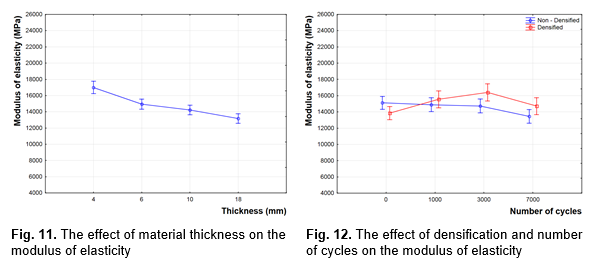
Figure 13 illustrates the effect of the interaction of densification and material thickness on the values of modulus of elasticity. Among the non-densified samples, a significant decrease in the values of modulus of elasticity occurred in the thickness range of 4 mm to 6 mm. In the thickness range of 6 mm to 18 mm there was an increase in the examined values that was on the verge of statistical significance.Among the samples treated by densification, a statistically insignificant increase in the values of modulus of elasticity occurred in the thickness range of 4 mm to 6 mm. In the thickness range of 6 mm to 18 mm, there was a significant decrease in the modulus of elasticity. Based on the results evaluating the effects of the interaction of material thickness and number of cycles on the values of the examined characteristics, it is apparent that a decrease in the values of modulus of elasticity for all of the examined number of cycles was recorded, caused by increases in the material thickness. The differences in the measured values proved to be statistically insignificant.
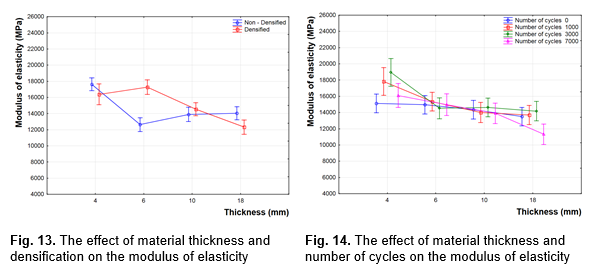
CONCLUSIONS
- Densification of the wood by rolling had a statistically insignificant effect on the bending strength and modulus of elasticity when loaded by bending. Densification of wood by rolling had no effect on the changes in the examined mechanical properties of wood at the determined level of densification.
- The effect of the increase in thickness expressed itself as a statistically significant decrease in the values of the examined characteristic during the evaluation of the bending strength and the modulus of elasticity.
- With an increase in material thickness, the values of the examined characteristics decreased, which was caused by an increase in the cross-sectional module of the material, which was greater than the increase of the affecting force.
- The number of cycles significantly impacted neither the ultimate bending strength values nor the elasticity modulus within the range of values measured herein. Material fatigue was not achieved as an effect of the examined number of cycles. The examined characteristics did not change as an effect of cyclic loading.
ACKNOWLEDGMENTS
The paper was partially supported by grant of the Ministry of Agriculture of the Czech Republic, NAZV, KUS, n. QJ 1330233 and the Internal Grant Agency of the Faculty of Forestry and Wood Science under project No. B05/15, “Properties of laminated materials based on wood and non-wood components.”
REFERENCES CITED
Blomberg, J., and Persson, B. (2007). “Swelling pressure of semi-isostatically densified wood under different mechanical restraints,” Wood Science and Technology 41(5), 401-415. DOI: 10.1007/s00226-006-0118-1
Blomberg, J., Persson, B., and Blomberg, A. (2005). “Effects of semi-isostatic densification of wood on the variation in strength properties in density,” Wood Science and Technology 39(5), 339-350. DOI: 10.1007/s00226-005-0290-8
Dubovský, J., Babiak, M., and Čunderlík, I. (2001). Textúra, štruktúra a úžitkové vlastnosti dreva (Texture, structure and utility characteristics of wood). 3rd Ed. Technical University in Zvolen, Slovakia. 106 pp. (in Slovak)
Fang, C. H., Mariotti, N., Cloutier, A., Koubaa, A., and Blanchet, P. (2012). “Densification of wood veneers by compression combined with heat and steam,” European Journal of Wood and Wood Products 70(1-3), 155-163.
DOI: 10.1007/s00107-011-0524-4
Gáborík, J., Dudas, J., and Kulík, J. (2010). “Selected properties of laminated wood of poplar,” Annals of Warsaw University of Life Sciences– SGGW. Forestry and Wood Technology No. 71, Warsaw University of Life Sciences Press, Warsaw, Poland, 182-186.
Gaff, M. (2014). “Three-dimensional pneumatic molding of veneer,” BioResources 9(3), 5676-5687. DOI: 10.15376/biores.9.3.5676-5687
Gaff, M., and Gáborík, J. (2014). “Effect of cyclic loading on the elasticity of beech solid and laminated wood,” BioResources 9(3), 4288-4296. DOI:10.15376/biores.9.3.4288-4296
Gaff, M., and Gašparík, M. (2015). “Influence of densification on bending strength of laminated beech wood,” BioResources 10(1), 1506-1518. DOI:10.15376/biores.10.1.1506-1518
Gaff, M., Gašparík, M., and Barcík, Š. (2014). “The influence of cyclic loading on ultimate bending strength of beech solid and laminated wood,” Drvna Industrija 65(3), 197-203. DOI: 10.5552/drind.2014.1336
Gaff, M., Macek, Š., and Zemiar, J. (2010). “Model analysis of laminar materials stressed by bending,” Annals of Warsaw University of Life Sciences– SGGW. Forestry and Wood Technology No. 71, Warsaw University of Life Sciences Press, Warsaw, Poland, 187-193.
ISO 13061-1 (2014). “Physical and mechanical properties of wood — Test methods for small clear wood specimens — Part 1: Determination of moisture content for physical and mechanical tests,” International Organization for Standardization, Geneva, Switzerland.
ISO 13061-3 (2014). “Physical and mechanical properties of wood — Test methods for small clear wood samples — Part 3: Determination of ultimate strength in static bending,” International Organization for Standardization, Geneva, Switzerland.
ISO 13061-4 (2014). “Physical and mechanical properties of wood — Test methods for small clear wood samples — Part 4: Determination of modulus of elasticity in static bending,” International Organization for Standardization, Geneva, Switzerland.
Kamke, F. A. (2006). “Densified radiate pine for structural composites,” Maderas Ciencia y Technología 8(2), 83-92. DOI: 10.4067/S0718-221X2006000200002
Kurjatko, S., Čunderlík, I., Dananajová, J., Dibdiaková, J., Dudas, J., Gáborík, J., Gaff, M., Hrčka, R., Hudec, J., Kačík, F., Kúdela, J., Lagaňa, R., Laurová, M., Mamoň, M., Mišíková, O., Račko, V., Rohanová, A., and Solár, R. (2010). “Parametre kvality dreva určujúce jeho finálne použitie [Wood quality parameters determining its end use],” Monograph, Technical University in Zvolen, 352 pp. (in Slovak).
Laine, K., Rautkari, L., Hughes, M., and Kutnar, A. (2013). “Reducing the set-recovery of surface densified solid Scots pine wood by hydrothermal post-treatment,” European Journal of Wood and Wood Products 71(1), 17-29. DOI: 10.1007/s00107-012-0647-2
Zemiar, J., Zbončák, R., and Gaff, M. (2011). “Thickness changes of cyclical pressed veneer,” Annals of Warsaw University of Life Sciences– SGGW. Forestry and Wood Technology No. 76, Warsaw University of Life Sciences Press, Warsaw, Poland, 218-222.
Article submitted: August 19, 2015; Peer review completed: October 24, 2015; Revised version received: November 3, 2015; Accepted: November 7, 2015; Published: November 24, 2015.
DOI: 10.15376/biores.11.1.599-611
